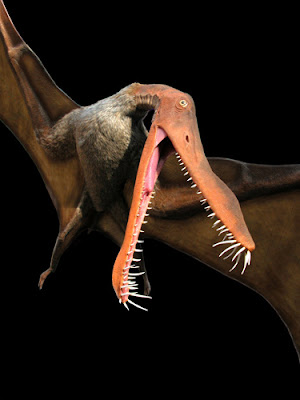This is exhibit is right up our alley. For the next few months, the Pittsburgh Museum of Natural History is displaying strange prehistoric critters as part of its "Bizarre Beasts" series. Descriptions provided by the Museum.
Helicoprion
A coil of teeth caps the lower jaw of a sculpture of a 13-foot (4-meter) whorl-tooth shark, or Helicoprion, a fish genus that lived about 250 million years ago.
Artist Gary Staab depicts the animal's jaw as something of a spiral conveyor belt, in which new teeth would advance to replace old ones (concealed here by skin) . But the true arrangement and purpose of the teeth remains a mystery. Some scientists suggest that it may have operated like a spiked whip, possibly curled underneath the lower jaw like a weaponized elephant trunk.
So new to science that it hasn't even been named yet, this African pterosaur lived alongside dinosaurs about 110 million years ago in the Cretaceous period.
Nail-like teeth and a 16-foot (5-meter) wingspan likely helped the flyer catch,Aeiand hold onto,Aeifish from African rivers, according to University of Chicago paleontologist Paul Sereno, whose team discovered the species in the Sahara of Niger.
Diatryma gigantean
They call 55-million-year-old Diatryma gigantean a terror bird. And the evidence is compelling.
This flightless species stood some seven feet (two meters) tall and was armed with a strong beak and powerful clawed feet. In North America and western Europe, scientists say, Diatryma likely took over as top predators once the dinosaurs had died off,Aeipossibly even hunting ancestors of today's horses.
Personally I think it is another incorrectly identified prehistoric creature.
supposition even when based on what may seem cast iron clad evidence, doesn't necessarily mean this fellow had a circular saw for his dental arrangement.
My theory would be, the lower jaw was squashed over the millennia forming the circular jaw, Just think how that jaw would work, it would act like a axe, splitting its prey in two, either side of the mouth !